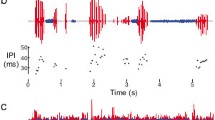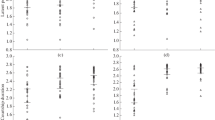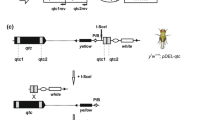Abstract
Mutations on the period locus of Drosophila melanogaster influence circadian periods as well as the rhythm in inter-pulse intervals in male courtship song; per L mutations produce long circadian periods and courtship song rhythms and per s mutations produce short circadian periods and courtship song rhythms. Thus, these mutations influence timing mechanisms over both long and short behavioral time horizons. We examined if the mean courtship duration of male Drosophila melanogaster cycles rhythmically, and if mutations at the period locus influence courtship bout duration. We measured the courtship bout durations of the following: (1) wild type Canton-S (per +) males; (2) per L males; and (3)per s males. Rhythmicity of courtship bout duration could not be mathematically determined. Mean courtship bout duration did not differ among the three groups; thus, mutations at the period locus did not influence mean courtship duration. There was a nonsignificant trend for per + males that were successful at mating to have longer mean courtship duration than unsuccessful males.
Similar content being viewed by others
REFERENCES
Alt, S., Ringo, J., Talyn, B., Bray, W., and D. Dowse, D. (In press). The period gene controls courtship song cycles in Drosophila melanogaster. Anim. Behav.
Bastock, M. and Manning, A. (1955). The courtship of Drosophila melanogaster. Behavior 8:85–111.
Bennet-Clark, H. C., and Ewing, A. (1967). Stimuli provided by courtship of male Drosophila melanogaster. Nature 215:669–671.
Burnet, B., and Connolly, K. J. (1974). Activity and sexual behavior in Drosophila melanogaster. In Van Abeelen, J. H. F. (ed.), The Genetics of Behavior, North Holland Publication Co, Amsterdam.
Casares, P., Carracedo, M. C., San Migues, Pineiro, E. R., and Garcia-Florez, L. (1993). Male mating speed in Drosophila melanogaster: Differences in genetic architecture and in relative performance according to female genotype. Behav. Genet. 23:349–358.
Chatfield, C. (1980). The analysis of time series. Chapman and Hall, London.
Connolly, K. J., and Cook, R. (1973). Rejection responses by female Drosophila melanogaster: their ontogeny, causality, and effects upon the behavior of the courting male. Behaviour 44:142–166.
Cowling, D. E. and Burnet, B. (1981). Courtship songs and genetic control of their acoustic characteristics in sibling species of the Drosophila melanogaster subgroup. Anim. Behav. 29:924–935.
Dowse, H. B., and J. M. Ringo (1989) The search for hidden periodicities in biological time series revisited. J. Theor. Biol. 139:487–515.
Ewing, L. S., and Ewing, A. W. (1984). Courtship in Drosophila melanogaster in large observation chambers: the influence of female reproductive state. Behavior 101:243–252.
Greenacre, M. L., Ritchie, M. G., Byrne, B. C., and Kyriacou, C. P. (1993). Female song preference and the period gene in Drosophila. Behavior Genetics 23:85–90.
Gromko, M. H. and Markow, T. A. (1993). Courtship and remating in field populations of Drosophila. Anim. Behav. 45:253–262.
Jallon, J-M (1984). A few chemical words exchanged by Drosophila during courtship and mating. Behav. Genet. 14:441–478.
Konopka, R. J., and Benzer, S. (1971). Clock mutants of Drosophila melanogaster. Proc. Natl. Acad. Sci. USA 68:2112–2116.
Kyriacou, C. P., and Hall, J. C. (1980). Circadian rhythm mutations in Drosophila affect short-term fluctuations in the male's courtship song. Proc. Natl. Acad. Sci. 77:6929–6233.
Kyriacou, C. P., and Hall, J. C. (1989). Spectral analysis of Drosophila courtship song rhythms. Anim. Behav. 37:850–859.
Markow, T. A. and Hanson, S. J. (1981). Multivariate analysis of Drosophila courtship. Proc. Natl. Acad. Sci. 78:430–434.
Parker, G. A. (1983). Mate quality and mating decisions. In: Mate Choice (Bateson, P., ed.). Cambridge Univ. Press, Cambridge. pp. 141–166.
Spieth, H. T. (1952). Mating behavior within the genus Drosophila (Diptera). Bull. Am. Mus. Nat. Hist. 99:401–474.
Spieth, H. T. (1974). Courtship behavior in Drosophila. Ann. Rev. Entomol. 19:385–405.
Spieth, H. T. and Ringo, J. M. (1983). Mating behavior and sexual isolation in Drosophila. In Ashburner, M., Carson, H. and Thompson, J. (eds.), The Genetics and Biology of Drosophila, Vol. 3., Academic Press, New York, pp. 223–284.
Van den Berg, M. J. (1985). The influence of isolation during rearing on male vigor in D. melanogaster. Drosophila Information Service 60:179.
Author information
Authors and Affiliations
Rights and permissions
About this article
Cite this article
Roche, J.P., Talyn, B.C.P. & Dowse, H.B. Courtship Bout Duration in per Circadian Period Mutants In Drosophila melanogaster . Behav Genet 28, 391–394 (1998). https://doi.org/10.1023/A:1021625819967
Issue Date:
DOI: https://doi.org/10.1023/A:1021625819967




